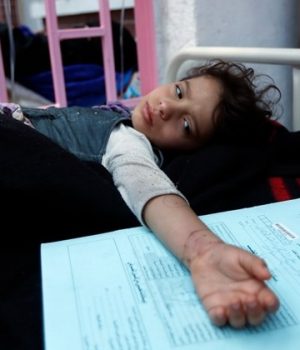On the 20th of May, 2017, the United States and Kingdom of Saudi Arabia (KSA) finalized a $110 billion arms deal which will support the Saudi campaign against the Houthi rebels in Yemen. The Houthi rebels are a Shia military wing that do not represent the whole of the Shia population. This misrepresentation negatively affects the entirety of the Shia minority. Saudi bombing and tactics pushed the Human Rights Watch to call for the suspension of arms deals to the Kingdom of Saudi Arabia as the Saudi-led coalition “unlawfully attacked homes, markets, hospitals, schools, civilian businesses, and mosques.”[1] On June 6, Saudi warplanes struck a health center treating cholera patients in the extreme northwest in Sa’ada Province, according to Yemen’s al-Masirah television network.
The resulting infrastructural destruction from attacks in the Shia-concentrated region has led not only to a massive community of dispersed Shia Muslims, but also a plummeting standard of living. This lower living standard leads to the ingestion of food contaminated with the bacterium vibrio cholerae, causing a massive outbreak of cholera, a disease easily prevented and cured with the immediate replacement of fluids and salts.
The total number of deaths from the cholera outbreak in Yemen passed 600, 40% of whom are children.[2] According to the World Health Organization (WHO), “The average daily number of cases recorded between May 21-27 was 2,529 – down from 3,025 in the previous seven days.”[3] Supplies are running dangerously low and are depleted further by untrained medical personnel.
Despite the widespread despair and calls for ceasefire and humanitarian support, 60,000 cases have been reported and UN Officials predict 150,000 more will occur within the next six months. Conflict between the Houthi’s and Saudi Arabia, the shrinking supply of fresh water, and malnutrition throughout the region each have caused damage that will remain unresolved unless there is a change in the political environment of the region. This degradation of basic human needs is just a one of the major factors that contribute to the flaring of cholera and other easily preventable diseases.
Due to the lack of infrastructure and the challenge of arranging a ceasefire from both sides, it is difficult for aid to be shipped into the region. Only one port, Hodeidah, is still able to receive shiploads of food and medicine. This conflict has negatively affected the Shia population within Yemen, and they are still struggling to cope with the destruction caused by the war. According to UN Aid Official Stephen O’Brien in an interview with The New York Times, “More than 17 million Yemenis are food insecure, and 6.8 million are one step away from famine.” This shortage has created one of the largest present-day food security crisis in the world. He later asserts, “families are increasingly marrying off their young daughters to have someone else care for them, and often use the dowry to pay for basic necessities.”
This conflict has negatively affected the Shia population within Yemen, and they are still struggling to cope with the destruction caused by the war. According to UN Aid Official Stephen O’Brien in an interview with The New York Times, “More than 17 million Yemenis are food insecure, and 6.8 million are one step away from famine.” This shortage has created one of the largest present-day food security crisis in the world. He later asserts, “families are increasingly marrying off their young daughters to have someone else care for them, and often use the dowry to pay for basic necessities.”[4] This marriage process provides the family with a dowry from the groom’s family, affording the bride’s family funds for food and medical care badly needed. The daughter will also be promised better care than what her family could afford.
As the number of remaining hospitals dwindle and the demand for aid surges, medical staff are overworked, underpaid, and have little to no room available for patients. Dr. Mohammed Zaid tells The Guardian, “I personally received 180 cases in one day. People are left lying in the corridors and in some cases, we are having to put six children in one bed.”[5] Also according to The Guardian, a doctor in the city of Sana’a stated that “his hospital had been receiving more than 100 suspected cases an hour.”[6]
The continuing campaign against the Saudi coalition, of which both the United States and the United Kingdom take part, abases the living conditions of the Yemeni Shia population. The result of the destruction of basic infrastructure has led to signs of cholera in October 2016 and has escalated to proportions of an epidemic in April of this year. Hospitals are overworked, personnel unpaid, and the humanitarian values that most of the members of the active coalition demand from others are completely ignored.
Human rights organizations must call upon the United States, as verbal promoters of peace and human rights, to follow through on expectations they themselves demand as they provide the KSA with weapons that would no doubt fuel the conflict against the Yemeni Shia. As a country that has fought both through rhetoric and the use of arms against states of oppression, the United States’ ideals are expected to remain undaunted in the face of oppression against Shia in Yemen. Humanitarian organizations urge the international community to acknowledge the institutionalized degradation of Shia living standards within Yemen and to encourage a statewide solution for equal protection of Yemeni Shia.
[1] https://www.hrw.org/news/2017/01/12/yemen-no-accountability-war-crimes
[2] http://shiawaves.com/english/world/4291-saudi-jets-hit-yemen-s-cholera-treatment-center
[3] http://shiawaves.com/english/islam/4271-who-cholera-death-toll-rises-to-471-in-yemen
[4] https://www.nytimes.com/2017/05/30/world/middleeast/yemen-civil-war-cholera-famine-girls-marriage-united-nations.html
[5] https://www.theguardian.com/global-development/2017/may/24/scientists-race-against-time-yemen-deadly-cholera-outbreak-spirals
[6] Ibid.










